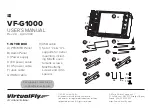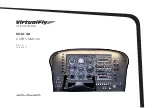
- 27 -
CLEANING INSTRUCTIONS
Daily Cleaning
The case should be cleaned thoroughly, as described in the weekly cleaning section, before it is
used for the first time.
NOTICE:
Avoid splashing or soaking any electrical components with water to
prevent electrical damage to the case.
NOTICE:
Shut off lights and power switches and remove all product from case.
Allow sufficient time for the unit to reach room temperature before
proceeding with cleaning.
NOTICE:
Remove all product from case before proceeding with cleaning
procedure.
NOTICE:
Acrylic front air deflector requires special washing procedures to
prevent hazing and yellowing of material.
NOTICE:
This case is not designed to be cleaned by flushing.
Note: For major spills or foreign material buildup use complete weekly cleaning instructions.
Note: Detergents are not recommended. To prevent scratching of surfaces, do not use abrasive
cleaners or pads.
1.
Clean all foreign materials from the door opening.
2.
Wipe complete interior of both the upper & lower areas of case using a damp cloth.
3.
On SSRC cases only, the upper front glass can be tilted open to allow easier access to clean the
upper section interior. Tilt the front glass up by standing in front of the case and grabbing the
handle at the bottom of the glass and lifting the bottom of the glass upward. The glass can then
be cleaned with common window cleaners. Close the glass by pulling the front handle of glass
down to the closed position.
4.
The remaining exterior surface should be wiped down using any ammoniated cleaners or soapy
warm water.
5.
IMPORTANT: Cleaning the clear acrylic plastic front air deflector require special care to
prevent hazing and yellowing of material. Lightly dust (not wipe) surface with clean soft cloth.
Then the surface can be wiped carefully with a soft, wet cloth or chamois. The cloth or chamois
must be kept free of grit by frequently rinsing in clean water. Grease and oil can be removed
with kerosene. Do not use window cleaners or kitchen scouring compounds. DO NOT use
solvents such as Acetone, Benzene, Carbon Tetrachloride, and Lacquer Thinners. A spray wax
such as Pledge or Maguire’s polish can be applied and wiped with a clean soft cloth. The wax
tends to fill in and hide small scratches.
.
All manuals and user guides at all-guides.com




































